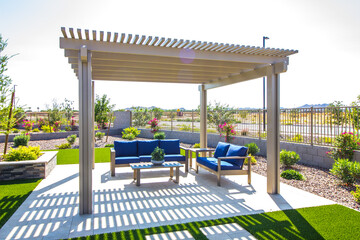Pergolas Seattle are a fantastic way to separate areas of your garden. They can be made of fabric, retractable awnings, or even hard-transparent panels that allow plenty of sunlight and provide protection from rain and debris. Many pergolas also have a retractable privacy screen that you can open or close as you see fit. In addition, climbing vines and privacy hedges can be planted near pergolas to block out unwanted views.

There are two main ways to install a pergola: either using a kit or installing it yourself. To install a pergola yourself, you can either contact a landscape professional in your area or design and purchase a pergola kit. Pergola kits come from well-known manufacturers and are usually rectangular in shape with pre-determined dimensions. Pergola kits are delivered to your home and assembled by a professional. They will require some simple tools.
Once the posts are in place, it’s time to attach the rafters. Pressure-treated posts are a good choice because they will last a long time and are inexpensive. If you’re building a pergola for the first time, consider adding decorative clamshells to the ends of the posts. If you live in an area with freezing ground, concrete footings are a better choice. Depending on your preferences, you can paint or stain the frame or use decorative paint.
Whether you want a pergola for privacy or shade, a pergola can add a dramatic focal point to your outdoor space. Pergolas can also be useful as a partition for the garden. Wires can train plants to grow in the pergola, creating shade and privacy. Pergolas can even serve as a wildlife habitat. So, you don’t have to just use your pergola for entertaining. Just make sure you plan ahead.
In addition to wood, pergolas are also made from aluminum, PVC, and fiberglass. While aluminum pergolas require less maintenance than cedar, they do need regular painting or treatment. It would be best if you also were on the lookout for mildew, which can destroy a pergola. A mixture of water and bleach can treat mildew. But these types of materials are not ideal for particularly harsh climates. Instead, consider metal pergolas if you live in a harsh climate.
While aluminum pergolas are inexpensive and can last for many years, vinyl pergolas tend to deteriorate in the rain or snow. They may also require power washing, and high-quality vinyl is very expensive. On the other hand, aluminum pergolas have a clean, modern look and don’t require a lot of maintenance. They don’t rust and are relatively inexpensive. They are also easier to maintain than pressure-treated wood. There are different types of materials for pergolas, but aluminum pergolas are the most popular option.
Pergolas are similar to arbors but are smaller and more rectangular. Arbors have walls that support climbing plants and often serve as an entrance into a garden. Pergolas can also incorporate trellises or be made of wood. These are unique outdoor structures. The number of columns will depend on the size of the pergola. They are a great choice for homes with limited space. A pergola can transform your backyard into a beautiful, unique outdoor living space when constructed properly.
A mahogany pergola can cost anywhere from $4,500 to $9,000. This type of pergola is not typically available as a prefab kit. Mahogany is an exotic hardwood, so it is difficult to work with. It may take more than one person to build an attractive and durable pergola. A mahogany pergola also requires a lot of maintenance. Mahogany is not naturally moisture-resistant, so you will want to invest in a proper care plan.
The materials used in pergola construction also vary. While wood has traditionally been the preferred material, modern pergolas can also be made from aluminum or vinyl. Pergolas made of cedar are more premium and can be stained or painted to match the rest of your home’s design. You can also purchase prefabricated pergola kits made of cedar, redwood, or pine. A cedar pergola will require less maintenance and will last for a long time.